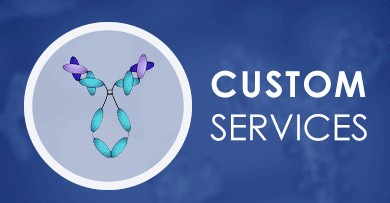 Loading...
Loading...

RIPK1
 Loading...
Loading...Anti-RIPK1 Products
-
- Species Reactivity: Human
- Type: Rabbit IgG
- Application: WB, FC
-
- Derivation: Rabbit
- Species Reactivity: Human
- Type: Rabbit IgG
- Application: WB, FC
-
- Species Reactivity: Human
- Type: Rabbit IgG
- Application: WB
-
- Species Reactivity: Human
- Type: Rabbit IgG
- Application: WB
-
- Species Reactivity: Mouse
- Type: Rabbit IgG
- Application: WB, IHC-P, ICC, IF, IP
- AbPlus™ Anti-RIPK1 Magnetic Beads (VS-0724-YC430) (VS-0724-YC430)
-
- Target: RIPK1
- Target Species: Human
- Application: IP, Protein Purification
-
- Derivation: Mouse
- Species Reactivity: Human
- Type: Mouse IgG1, κ
- Application: WB, IP, IF, ELISA
- Chicken Anti-RIPK1 Polyclonal IgY (BRD-0511MZ)
-
- Species Reactivity: Human
- Type: Chicken antibody
- Application: WB
-
- Derivation: Phage display library screening
- Species Reactivity: Human
- Type: IgG
- Application: WB
-
- Species Reactivity: Human
- Type: Rabbit IgG
- Application: WB, FC
- Mouse Anti-RIPK1 Recombinant Antibody (clone 3B5B6) (VS7-0425-WR783)
-
- Species Reactivity: Human
- Type: Mouse IgG1
- Application: WB
- Anti-RIPK1 Immunohistochemistry Kit (VS-0525-XY6131)
-
- Species Reactivity: Human
- Target: RIPK1
- Application: IHC
- Anti-Human RIPK1 Immunohistochemistry Kit (VS-0525-XY6132)
-
- Species Reactivity: Human, Canine, Monkey
- Target: RIPK1
- Application: IHC
- Rabbit Anti-RIPK1 Recombinant Antibody (VS-0725-YC73)
-
- Species Reactivity: Mouse
- Type: Rabbit IgG
- Application: IHC-P, WB
Can't find the products you're looking for? Try to filter in the left sidebar.Filter By Tag
Our customer service representatives are available 24 hours a day, from Monday to Sunday. Contact Us
For Research Use Only. Not For Clinical Use.
Background
Disease related genes, Enzymes, Metabolic proteins, Potential drug targets
Intracellular
Low cell type specificity
Low immune cell specificity
Low cell line specificity
Homodimer (PubMed:29440439, PubMed:29681455). Interacts (via RIP homotypic interaction motif) with RIPK3 (via RIP homotypic interaction motif); this interaction induces RIPK1 phosphorylation and formation of a RIPK1-RIPK3 necroptosis-inducing complex (PubMed:11734559, PubMed:29883609, PubMed:19524512, PubMed:10358032, PubMed:29681455). Upon TNF-induced necrosis, the RIPK1-RIPK3 dimer further interacts with PGAM5 and MLKL; the formation of this complex leads to PGAM5 phosphorylation and increase in PGAM5 phosphatase activity (PubMed:22265414). Interacts (via the death domain) with TNFRSF6 (via the death domain) and TRADD (via the death domain) (PubMed:8612133). Is recruited by TRADD to TNFRSF1A in a TNF-dependent process (PubMed:24130170). Binds RNF216, EGFR, IKBKG, TRAF1, TRAF2 and TRAF3 (PubMed:8612133, PubMed:9927690, PubMed:11854271, PubMed:11116146). Interacts with BNLF1 (PubMed:10409763). Interacts with SQSTM1 upon TNF-alpha stimulation (PubMed:10356400). May interact with MAVS/IPS1 (PubMed:16127453). Interacts with ZFAND5 (PubMed:14754897). Interacts with RBCK1 (PubMed:17449468). Interacts with ZBP1 (By similarity). Interacts with BIRC2/c-IAP1, BIRC3/c-IAP2 and XIAP/BIRC4 (PubMed:21931591). Interacts (via kinase domain) with DAB2IP (via Ras-GAP domain); the interaction occurs in a TNF-alpha-dependent manner (PubMed:17389591, PubMed:15310755). Interacts with ARHGEF2 (PubMed:21887730). Interacts (via protein kinase domain) with RFFL; involved in RIPK1 ubiquitination (PubMed:18450452). Interacts with RNF34; involved in RIPK1 ubiquitination (Ref. 34). Interacts with TICAM1 and this interaction is enhanced in the presence of WDFY1 (PubMed:25736436). Interacts with PELI1 (PubMed:29883609). Interacts (via death domain) with CRADD (via death domain); the interaction is direct (PubMed:9044836). Component of complex IIa composed of at least RIPK1, FADD and CASP8 (By similarity). Component of the AIM2 PANoptosome complex, a multiprotein complex that drives inflammatory cell death (PANoptosis) (By similarity). Interacts with MAP3K7, CFLAR, CASP8, FADD and NEMO (By similarity). (Microbial infection) Interacts with mumps virus protein SH; this interaction inhibits downstream NF-kappa-B pathway activation. (Microbial infection) Interacts with Murid herpesvirus 1 protein RIR1. (Microbial infection) Interacts (via RIP homotypic interaction motif) with herpes simplex virus 1/HHV-1 protein RIR1/ICP6 (via RIP homotypic interaction motif); this interaction prevents necroptosis activation. (Microbial infection) Interacts (via RIP homotypic interaction motif) with herpes simplex virus 2/HHV-2 protein RIR1/ICP10 (via RIP homotypic interaction motif); this interaction prevents necroptosis activation.
Kinase, Serine/threonine-protein kinase, Transferase

